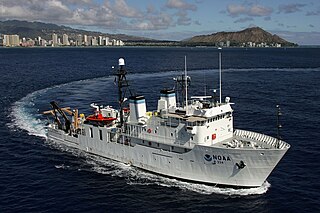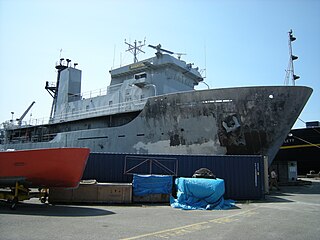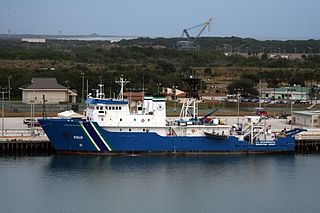
A small waterplane area twin hull, better known by the acronym SWATH, is a catamaran design that minimizes hull cross section area at the sea's surface. Minimizing the ship's volume near the surface area of the sea, where wave energy is located, minimizes a vessel's response to sea state, even in high seas and at high speeds. The bulk of the displacement necessary to keep the ship afloat is located beneath the waves, where it is less affected by wave action. Wave excitation drops exponentially as depth increases, so wave action normally does not affect a submerged submarine at all. Placing the majority of a ship's displacement under the waves is similar in concept to creating a ship that rides atop twin submarines.

USNS Stalwart (T-AGOS-1) was a Modified Tactical Auxiliary General Ocean Surveillance Ship and the lead ship of her class.

USNS Vindicator (T-AGOS-3) was a United States Navy Stalwart-class modified tactical auxiliary general ocean surveillance ship that was in service from 1984 to 1993. Vindicator then served in the United States Coast Guard from 1994 to 2001 as the medium endurance cutter USCGC Vindicator (WMEC-3). From 2004 to 2020, she was in commission in the National Oceanic and Atmospheric Administration (NOAA) fleet as the oceanographic research ship NOAAS Hi'ialakai.

USNS Triumph (T-AGOS-4) is a Stalwart-class ocean surveillance ship formerly of the United States Navy. She was struck from the Naval Vessel Register in 1995. On 1 October 2012 the ship was disposed of by Navy title transfer to the Maritime Administration. As of May 2015, Triumph was held as a reserve asset for spare parts for sister ships General Rudder and State of Michigan.

NRP Almirante Gago Coutinho (A523) is a ship of the Portuguese Navy' Dom Carlos I-class survey vessels. Before transfer to the Portuguese Navy, Almirante Gago Coutinho was formerly USNS Assurance (T-AGOS-5) of the United States Navy.

USNS Indomitable (T-AGOS-7) was a United States Navy Stalwart-class ocean surveillance ship in service from 1985 to 2002. From 2003 until 18 June 2014, she was in commission in the National Oceanic and Atmospheric Administration (NOAA) as the oceanographic research ship NOAAS McArthur II. As of 2018 it serves as a mother ship now named the Deep Submersible Support Vessel (DSSV) Pressure Drop for the crewed deep-ocean research submersible DSV Limiting Factor.

Prevail (IX-537) is a modified Stalwart-class auxiliary general ocean surveillance ship (AGOS) of the United States Navy previously operated by the U.S. Military Sealift Command as T-AGOS 8. Prevail was reclassified as Unclassified Miscellaneous (IX) in October 2003 and is unofficially referred to as TSV-1. In this context, TSV stands for Training Support Vessel, and should not be confused with the U.S. Army's USAV Spearhead Theater Support Vessel initiative.

USNS Assertive (T-AGOS-9) was a Stalwart-class Modified Tactical Auxiliary General Ocean Surveillance Ship of the United States Navy.

The Ocean Survey Vessel (OSV) Bold was operated by the United States Environmental Protection Agency. Originally commissioned as the USNS Vigorous, it was renamed USNS Bold (T-AGOS-12) and was a Stalwart-class Auxiliary General Ocean Surveillance Ship of the [Military Sealift Command of the United States Navy, as designated by the "T" preface to her AGOS classification]. Stalwart class ships were originally designed to collect underwater acoustical data in support of Cold war anti-submarine warfare operations in the 1980s.

USNS Titan (T-AGOS-15) was a Stalwart-class modified tactical auxiliary general ocean surveillance ship in service in the United States Navy from 1989 to 1993. From 1996 to 2014, she was in commission in the National Oceanic and Atmospheric Administration (NOAA) fleet as the oceanographic research ship NOAAS Ka'imimoana.

USNS Capable (T-AGOS-16) was a Stalwart-class modified tactical auxiliary general ocean surveillance ship of the United States Navy in service from 1989 to 2004. In 2008, she was commissioned into service in the National Oceanic and Atmospheric Administration as the oceanographic research ship NOAAS Okeanos Explorer.

USNS Relentless (T-AGOS-18) was a Stalwart-class modified tactical auxiliary general ocean surveillance ship in service in the United States Navy from 1990 to 1993. Since 1998, she has been in commission in the National Oceanic and Atmospheric Administration (NOAA) fleet as the fisheries research ship NOAAS Gordon Gunter.

USNS Bowditch (T-AGS-21) was the lead ship of her class of oceanographic survey ships for the United States Navy. Launched as the SS South Bend Victory in 1945, Maritime Commission hull number MCV 694, a type VC2-S-AP3 Victory ship, she was named for Nathaniel Bowditch, the second U.S. Navy vessel named in his honor. The ship was acquired by the Navy in August 1957 and converted to an AGS at Charleston Naval Shipyard. Named Bowditch on 8 August 1957 and placed in service 8 October 1958 for operation by the Military Sea Transportation Service (MSTS).
USNS Michelson (T-AGS-23) was a Bowditch class oceanographic survey ship of the United States Navy. Launched as the SS Joliet Victory in 1944, Maritime Commission hull number MCV 114, a type VC2-S-AP3 Victory ship, she was named after Albert Abraham Michelson. The ship was reactivated from the James River Maritime Administration Reserve Fleet on 8 February 1958, delivered to the Navy Department at the Philadelphia Naval Shipyard on 8 August 1957 and converted to an AGS by the Charleston Naval Shipyard. USNS Michelson (AGS‑23) was placed in service on 15 December 1958 under the operational control of MSTS Atlantic.

NOAAS Thomas Jefferson is a National Oceanic and Atmospheric Administration (NOAA) hydrographic survey vessel in service since 2003. The ship was built for the United States Navy as USNS Littlehales (T-AGS-52) serving as one of two new coastal hydrographic survey vessels from 1992 until transfer to NOAA in 2003 when it was named after Founding Father and third U.S. president, Thomas Jefferson.

USNS Able (T-AGOS-20) is a Victorious-class oceanographic survey ship in the service of the United States Navy's Military Sealift Command.

USS San Carlos (AVP-51) was a Barnegat-class seaplane tender built for the United States Navy during World War II. San Carlos, named after San Carlos Bay, Florida, was in commissioned from 1944 to 1947 and earned three battle stars for service in the Pacific during World War II. After eleven years in reserve, San Carlos was converted to oceanographic research ship USNS Josiah Willard Gibbs (T-AGOR-1)—named after American scientist Josiah Willard Gibbs—and placed in service as a non-commissioned ship of the Military Sea Transportation Service from 1958 to 1971. In December 1971, the ship was transferred to the Hellenic Navy as Hephaistos (A413), a motor torpedo boat tender. Hephaistos was struck from the rolls of the Hellenic Navy in April 1976.

USNS John McDonnell (T-AGS-51) was a hydrographic survey ship operated by the Military Sealift Command (MSC) with a contract crew for the Naval Oceanographic Office which assigned a military and civilian hydrographic detachment to conduct coastal surveys. The ship and its sister, USNS Littlehales (T-AGS-52), were replacements for the coastal hydrographic survey vessels USNS Chauvenet (T-AGS-29) and USNS Harkness (T-AGS-32).

















